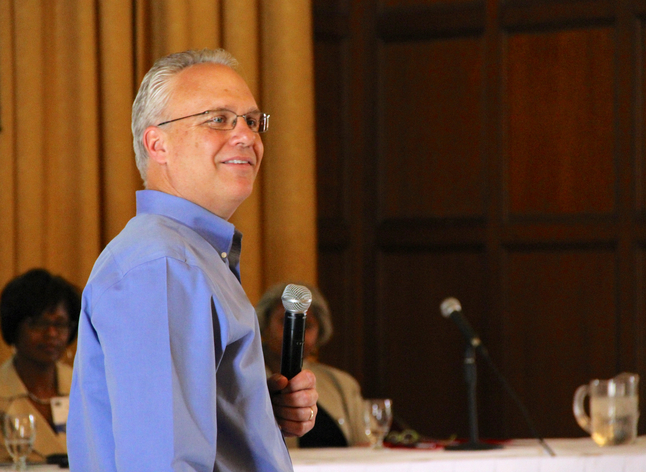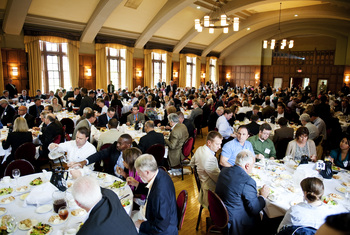
Rich Sheridan spoke about creating a "culture of joy" on the first day of the International Economic Development Council spring conference held at the Michigan League.
Ben Freed | AnnArbor.com
For Ann Arbor and Michigan, the conference was a chance to boast an economic recovery that has been heralded as the “second fastest in the nation,” and to show off local business success stories.
It also was a time to benchmark the region against others in the room and to find nuggets of inspiration to continue the area’s recent economic success. The conference was a study in seeming contradictions: the economy is booming, but there’s still a long way to go; and there are so many talented people, but we can’t find any of them.
Despite the jargon and buzzwords, a few lessons did emerge from the conference for the Ann Arbor community to take to heart.
1. Ann Arbor SPARK is respected by its peers
Ann Arbor SPARK is a ubiquitous presence in the Washtenaw County business community. Co-founded by Gov. Rick Snyder, (who was not governor at the time)who spoke at the conference, and University of Michigan president Mary Sue Coleman in 2006, the local public-private partnership has aided in the creation or retention of nearly 12,000 jobs according to its most recent annual report.
Among other activities, SPARK runs the SPARK Central and SPARK East startup incubators, assists businesses secure tax abatements for expansions and promotes Ann Arbor and the surrounding communities to companies large and small looking for a new home.
While SPARK has had its critics, the organization’s efforts over the past seven years have earned the respect of economic development organizations across the country. At the spring conference, Ann Arbor SPARK became just the 36th economic development organization in the country and the second in Michigan to be accredited by the IEDC.
Accreditation by the economic development council is not a basic standard of quality as it is for universities, but rather a stamp of excellence only achieved by organizations that meet specific benchmarks and milestones.
“Accreditation within our organization is still fairly rare,” IEDC executive director Jeff Finkle said. “It has been compared to getting the Baldrige award as a business. It really means that you are the top in your class.”
2. Collaboration, Collaboration, Collaboration
There were plenty of other buzzwords thrown around at the IEDC Spring Conference, but the one I heard the most by far was collaboration. If you add in the synonymous “creating partnerships,” the numbers become even more inflated.
So why is collaboration so difficult?

Audience members eat lunch at the Michigan League for the International Economic Development Council conference before hearing Governor Rick Snyder speak on Monday.
Daniel Brenner | AnnArbor.com
“People have to have their own self-interest on the line to make them collaborate. When the level of crises in a situation or an economic sector or a region is greater than the level of complacency, that’s when you get collaboration.”
Perhaps it was the level of crisis Michigan — especially Southeast Michigan — experienced that fostered the spirit of collaboration in the region and across the state. One major collaboration, the New Economy Initiative in Detroit, brought the area’s 10 largest foundations together to put $100 million towards improving the region’s economy.
“These groups came together to speed the transformation to the new knowledge economy and make sure that the local population is able to participate in it,” said Pamela Hurtt, a senior consultant for the initiative.
“The culture needed to change from one of entitlement to one of innovation. We wanted to take on projects that were bigger than any one foundation could have taken on alone.”
Other prominent collaborations in the state include Business Leaders for Michigan, whose members include the CEOs of the 80 largest companies in Michigan, and the Pure Michigan Business Connect network, an initiative that encourages local businesses to purchase goods and services from other Michigan companies.
3. No one has all the answers
This is more of a personal sentiment, and I certainly can’t say I have facts or figures to support the assertion.
“There’s an old adage, that when you’ve seen one economic development organization, you’ve seen one economic development organization,” SPARK CEO Paul Krutko said in an interview before the conference.
The saying certainly held true at the conference. Attendees included representatives from chambers of commerce, public-private partnerships, foundations, governmental organizations, and regional partnerships.
Many of the speakers used buzzwords and broad philosophies to impart their knowledge to the people in attendance, while others focused on specific tactics and strategies that helped grow their company’s profits or in their community’s GDP.
There are any number of commonly given prescriptions for turning around a business or a local economy, but if it was as easy as “being positive,” “embracing change” or “collaborating,” we probably wouldn’t have much use for economic development professionals at all.
Ben Freed covers business for AnnArbor.com. You can sign up here to receive Business Review updates every week. Get in touch with Ben at 734-623-2528 or email him at benfreed@annarbor.com. Follow him on twitter @BFreedinA2.